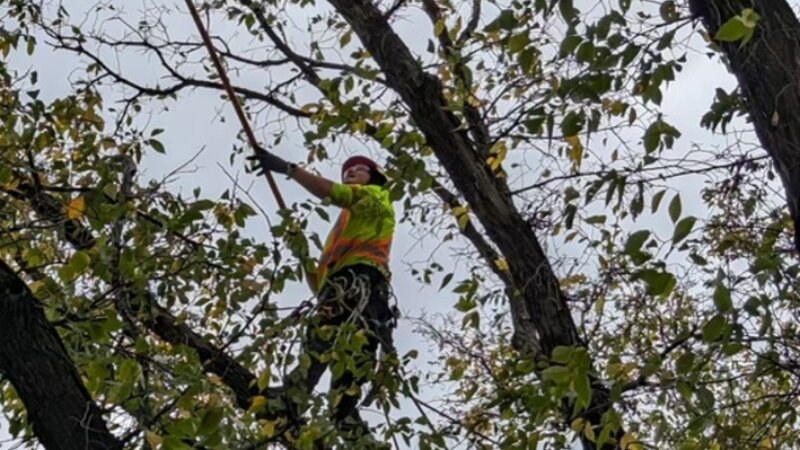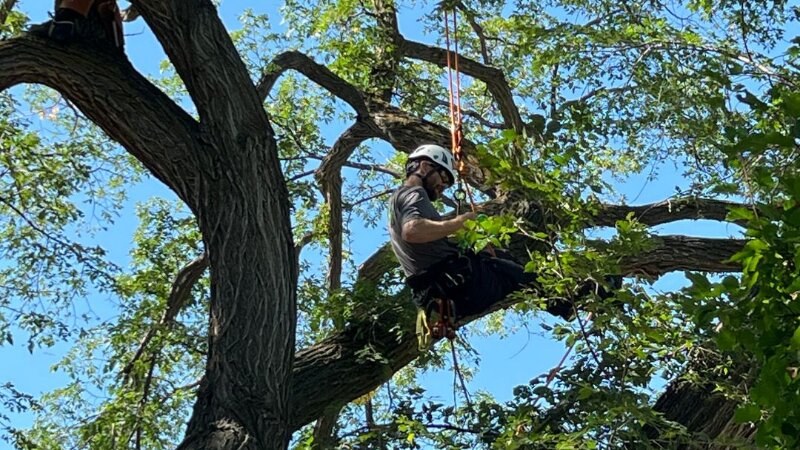In Focus: Tree Crown Reduction in Edmonton
Reading time: 6 minutesKeeping your trees healthy and beautiful takes time and serious commitment. You can use many strategies to prevent disease and maintain the aesthetic appearance of your tree. Crown reduction is just one of these important tools.
We explore crown reduction below and list 5 crucial rules you should follow if you decide to DIY.

What Is Tree Crown Reduction?
Crown reduction is the process of carefully selecting tree limbs and branches to cut away, primarily to control the size of the tree and improve its shape, appearance, and health.
Because of the way branches are selected before pruning, the size of a tree's crown can be condensed without affecting the tree's structure or causing harm. Ultimately, this promotes airflow and sunlight penetration throughout the tree's canopy and helps lower the risk of decay and disease.
Crown Reduction vs. Crown Cleaning vs. Tree Pruning
Many people confuse the term “crown reduction” with trimming, pruning, or even tree topping. However, each of these is a different activity with its unique results.
Crown cleaning refers to the removal of dead or diseased branches, while tree pruning is the process of cutting back branches such as for shape or to prevent them from reaching power lines.
Crown reduction is considered a type of tree pruning. There are also the practices of crown thinning and crown raising, which both fall in the category of trimming but are distinct from reduction.
Crown thinning refers to the selection of a tree’s interior branches at even spaces throughout the crown to reduce density and allow air and sunlight through.
Crown raising is the process of cutting lower branches to make it look like the crown starts higher up on the tree’s trunk. This can be helpful when bottom branches are obscuring your view or making parts of your property inaccessible.
Tree topping is not recommended and involves cutting off the entire tops of trees, leaving only stubs that produce thin water sprouts and patchy foliage. While this may rarely be the only way to save a tree, it almost always causes irreparable damage instead.
5 Key Crown Reduction Rules to Follow
When reducing the crown of a tree, there are some important rules to follow:
1. Never remove more than 20% of a tree at one time
Even though crown reduction is a healthy practice, it naturally puts stress on your tree. The more you cut, the more stress you’ll cause, so it’s important to be conservative with your loppers.
Avoid removing more than 20% of the tree during any reduction session since this could tip the scale from beneficial to harmful.
2. Wait a year before reducing your trees again
Ideally, you should wait at least a year between crown reduction sessions to allow your trees to recover and grow into their new shape.
Trimming or pruning again too soon causes extra stress that might ultimately weaken or damage your tree.
3. Avoid leaving large branch stubs on the tree
A tree stub is more than just unsightly; it can potentially cause damage or disease if left alone after cutting. This is because the stub prevents the tree from sealing the cut, which acts as a protective barrier against insects and disease.
4. Start with the 4 D’s
This refers to "dead, diseased, damaged, and deranged" branches, which are limbs that cross or rub up against one another.
These are the first branches that should be reduced or removed before cutting any of the tree’s healthy branches. Once this is done, you can reevaluate your tree and decide what other branches need to be trimmed or pruned.
5. Always use clean tools and sanitize them in between cuts
Tree diseases and pests can easily spread via fresh cuts or wounds in the bark, especially when you move from one tree to the next with the same loppers or shears.
Make sure you sanitize your tools after each cut, even on the same tree, so there’s less opportunity for pathogens to proliferate.

FAQs About Tree Crown Reduction in Edmonton
When is the best time of year for crown reduction?
Like all types of tree trimming and pruning, the ideal time for crown reduction is during a tree's dormant season. This is after the leaves fall off but well before the start of spring the following year. In Edmonton, this usually occurs between late September and early October and the middle of April.
When should I avoid crown reduction?
It’s best to avoid cutting your tree during the active growing season, which is generally from May to August. Not only can this cause more stress to your tree, but it can also cause sap “bleeding” in the spring. Improper cutting can also attract disease-carrying insects that could infest your tree.
How much can I cut before I cause damage?
Cutting more than 20% of your tree at once puts it at risk of stress and disease. Removing 30% or more of your tree's foliage-producing branches could cause the tree to die.
How do I know if my tree needs crown reduction?
Crown reduction can benefit trees that have grown too tall or spread out of control, especially if they start encroaching on buildings, homes, or power lines. It's also a good method to use if you have many diseased, dead, or damaged branches. If there are more than just a few, consider reducing the entire crown for safety and appearance.
How long does crown reduction take?
This depends on the size of your tree and the number of limbs and branches that need to be removed. Sometimes, it only takes a few hours to complete the job. In other cases, multiple sessions over several days are needed to calculate and remove the right limbs.
Why should I work with an ISA-certified arborist?
Certified arborists like the team at Green Drop put extra time and effort into learning how to preserve the health and beauty of Canada's trees. We use ecologically sound methods that cause less harm to surrounding habitats, so you and natural wildlife can enjoy the space for years to come.
When you work with us, you can trust that your trees and your environment will be well cared for according to the latest known science and research available to the International Society of Arboriculture.

When to Call the Professionals
Like almost every tree care service, it’s best to leave tree trimming, pruning, and removal to the professionals.
At Green Drop, an ISA-certified arborist can assess your tree and determine which services will keep your trees healthy and create your desired look. We use eco-friendly practices that help protect precious Canadian wildlife so you can have peace of mind that your beautiful yard doesn’t come at the cost of the environment.
In addition to Edmonton, we serve other parts of Western Canada, including Calgary, Red Deer, Regina, Saskatoon, and Winnipeg.

